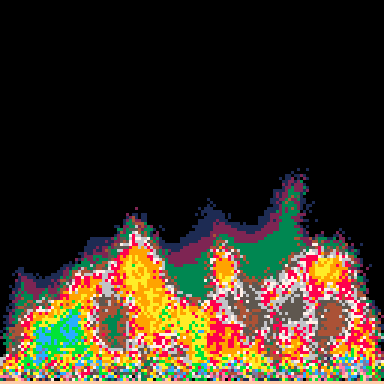PICO-8 Tweetcart Studies
distant fire
Author: 2DArray (@2DArray)
Link: https://twitter.com/2DArray/status/1021804854006693888

Colour Pattern
Summary
This is a really cool flame effect! It uses the spritesheet to store the actual energy of each pixel (0-15), then writes the corresponding colour to the screen.
Every time a pixel is rendered, its current energy and the energy of a random nearby pixel below it get added together (with some multiplying/dividing), and in the end that lets the cart create some amazingly natural-looking clouds above the smoke.
Even when pixels are rendered as totally black, there’s a good chance that there’s still energy in that spot – more energy for areas which are ‘hotter’ or have had flames burning through them recently. Which is really interesting, there’s more than meets the eye when you first look at this effect.
Pictures

Here we're showing what the spritesheet looks like (the real energy values that get stored).
At the end we switch to showing the actual screen values, see just how much energy data is in those areas that seem fairly empty.

This is what happens if we swap *2)/2.87 for *5)/5.87 when calculating c. The fire's more lively (white/red/etc travel higher) but the large clouds also dissipate quicker.
Tweet code
m=8192p=sget
a={0,1,2,14,9,8,10,7}
cls()line(0,127,127,127,15)
memcpy(0,m*3,m)::_::
x=rnd(128)
y=rnd(127)
u=x+rnd(3)-1.5
v=y+rnd(2.5)
c=(p(x,y)+p(u,v)*2)/2.87
sset(x,y,c)
pset(x,y,a[flr(c*c/32)+1])
goto _Breakdown
-- flame gradient
a={0,1,2,14,9,8,10,7}
-- empty screen
cls()
-- this line acts as the 'fuel' that starts the rest of
-- the fire going up. 15 is the highest value that can
-- be stored in a pico-8 pixel
line(0,127,127,127,15)
-- the sprite sheet is at 0x0000.
-- the screen data is at 0x6000.
-- copy that 'fuel line' down to the sprite sheet,
-- because the sprite sheet is where we actually store
-- and get our flame energy values from.
m=8192
memcpy(0,m*3,m)
-- start render loop. we render a single pixel per loop
::_::
-- which pixel are we rendering? we intentionally never
-- touch y=127 because that's where the fuel line lives
x=rnd(128)
y=rnd(127)
-- u,v is a nearby pixel underneath us that we're using
-- to determine the 'energy' of this pixel.
u=x+rnd(3)-1.5
v=y+rnd(2.5)
-- we're using sget() here to get the pixels from the
-- sprite sheet (the screen and the sprite sheet are
-- identical except the sprite sheet has the energy
-- values stored directly and the screen instead shows
-- colours from the above gradient based on energy).
-- if this pixel has energy, and the other nearby pixel
-- also has energy, this pixel will probably get some
-- more energy.
-- however, because of the /2.87 , if only this pixel
-- *or* a nearby pixel has energy then this pixel won't
-- get as much energy.
-- tweaking these values is gonna give you different
-- flame patterns and behaviour, much fun to be had!
c=(sget(x,y)+sget(u,v)*2)/2.87
-- store the new energy in the sprite sheet
sset(x,y,c)
-- write the new colour to the screen
pset(x,y,a[flr(c*c/32)+1])
-- we don't need flip() here, we're just trying to
-- render pixels as fast as possible and pico-8 will
-- grab the new frame whenever. we're never in a state
-- that looks bad or incomplete, so no need for flip.
goto _